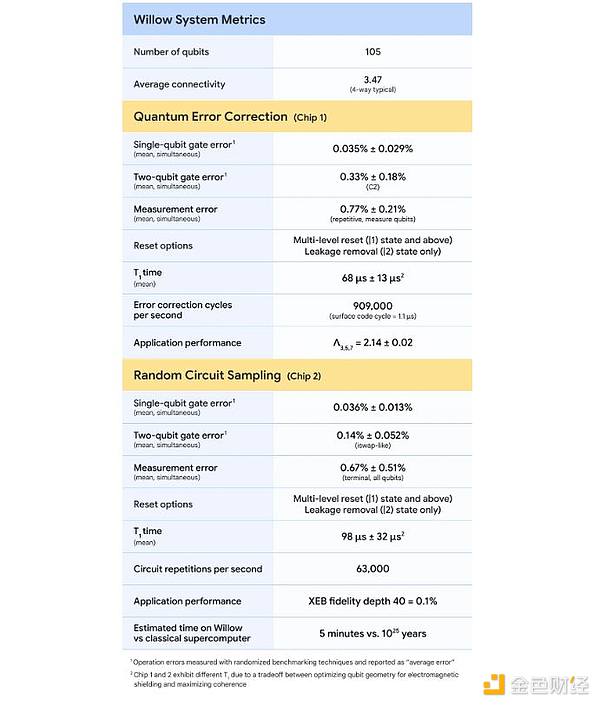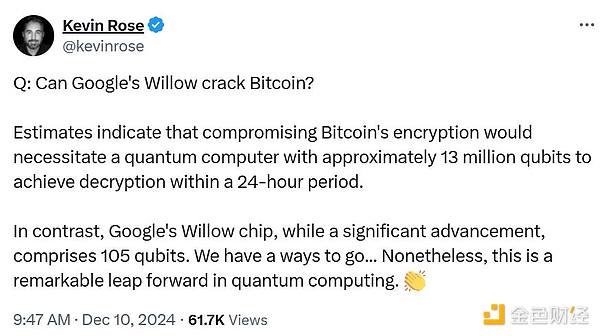Author: Stephen Katte, CoinTelegraph; Compiler: Baishui, Golden Finance
Google's quantum artificial intelligence team has released its new quantum computing chip, which can solve a calculation problem in less than five minutes, while one of the best supercomputers would take about 1 billion years to solve the problem.
The chip, called Willow, can correct errors exponentially and process certain calculations at incredible speeds, Hartmut Neven, head of Google's quantum artificial intelligence, said in a blog post on December 9.
"This incredible number exceeds the time scale known in physics and far exceeds the age of the universe," he said.
"This confirms the idea that quantum computing occurs in many parallel universes, which is consistent with the idea that we live in a multiverse, a prediction first proposed by David Deutsch," Neven added.
The second major achievement the team achieved with Willow, according to Neven, is that it was able to reduce errors exponentially as it scaled up using more qubits, cracking the "key challenge" of quantum error correction that experts in the field have "pursued for nearly 30 years."
"Using our latest advances in quantum error correction, we were able to reduce the error rate by half. In other words, we achieved an exponential reduction in the error rate."

The Google Quantum AI team said their new quantum computing chip, Willow, performed well on multiple metrics. Source: Google
“This historic achievement is known in the industry as being ‘below the threshold’ – being able to reduce the error rate while increasing the number of qubits,” Neven added.
Qubits are the fundamental units of information and the key to quantum computing; the more qubits there are, the more computing power there is; however, adding more qubits increases the risk of errors.
If the error rate is too high, calculations become unreliable and produce erroneous results, making it difficult for the technology to be practical at scale.
In a Dec. 9 announcement to X, Google CEO Sundar Pichai said Willow is an important step in the tech giant’s journey to build a “useful quantum computer” that will have real-world applications in drug discovery, fusion energy, and battery design.

Source: Sundar Pichai
Google hopes to one day develop computers capable of complex, error-corrected calculations, and its quantum computing roadmap shows the company reaching two of six milestones in 2023.
Does Willow pose a threat to cryptocurrencies?
There have long been concerns that advances in quantum computing will be a turning point for the crypto industry. Computers capable of breaking encryption could expose user funds to thieves in large quantities and quickly.
Tech entrepreneur and former Google senior product manager Kevin Rose said in a Dec. 9 statement to X that Willow is far from a threat to encryption.
According to Rose, to crack Bitcoin’s encryption algorithm, a quantum computer with about 13 million qubits would be needed to decrypt it within 24 hours.
“In comparison, Google’s Willow chip, while a significant advance, only has 105 qubits,” he said.

Source: Kevin Rose
"We still have a long way to go. Nonetheless, this is still a major leap forward in quantum computing."
Meanwhile, David Marcus, CEO of payment platform Lightspark, said he believed most people did not "fully understand" the significance of Google's breakthrough.
Marcus said this means “post-quantum cryptography and encryption technology needs to start taking action.”
Ethereum co-founder Vitalik Buterin has proposed a way to mitigate the risk of quantum computing in ethereum, explaining in a March X article that a simple hard fork could overturn the problem.
Buterin said the blockchain would have to hard fork and users would have to download new wallet software, but few people would lose funds.
 JinseFinance
JinseFinance
 JinseFinance
JinseFinance JinseFinance
JinseFinance JinseFinance
JinseFinance Huang Bo
Huang Bo Edmund
Edmund JinseFinance
JinseFinance JinseFinance
JinseFinance Future
Future Cointelegraph
Cointelegraph Cointelegraph
Cointelegraph